All miniature painters are artists in my book. Even if you’re painting to a tabletop standard, I’m sure many of you would like to improve the quality of your miniature paint jobs. Painting miniatures requires the same mentality, core skills, and virtues that other fine artistic endeavors require. If you’re looking to improve your miniature painting, then there are key tried and true things you can learn from a millennia of traditional artists. Ultimately, you will find that there are 7 things you can do in your miniature painting hobby that all effective artists agree have helped them succeed.
In this article, I show you the 7 habits you should consider for improving your miniature painting. Here they are:
- Work Daily
- Volume, Not Perfection
- Copy Other Work
- Conscious Practice and Learning
- Rest
- Get Feedback
- Create What You Love
Read on for more details about how incorporating these habits into your miniature painting and modeling hobby can improve your work. As for myself, I’ve discovered that through years of painting miniatures that many of these habits developed naturally. And, I’m certainly still learning.
The information for how to improve painting miniatures doesn’t come without time, of course. But, if you’re just starting out in the hobby of mini painting, I hope this article accelerates your learning process. You may find that you already practice several of these habits, and have experienced how they helped you improve your miniature paint jobs. If so, please let me know in the comments below if you have any more tips that could help all of us get better at painting minis.
Here are the 7 habits of effective miniature painters:
1. Work Daily
This is the easiest and hardest habit to follow for becoming a better miniature painter. If you’re trying to improve your work, you need to do the work (a lot of it). From my understanding of the backstory of successful artists, e.g., painters, singers, photographers, there was a universal theme in how they approached making art. They made art every single day! They created something new every day they were awake.
Let’s get real. If you want to improve your miniature painting, you’ll need to put in the time.
I know from my experience working as a commissioned painter that I was “forced” to paint miniatures every day to meet deadlines. I had to reach expectations from my clients. This required me to devote time every evening (before I had kids) to painting miniatures. This obviously had the additional benefit of making me a better miniature painter by sheer necessity.
Look, maybe you think you can spend 3-5 hours on the weekends to paint miniatures and that will be enough. But, what adult can realistically find 3-5 hour free blocks of time in a single day? (Although I know a few video gamers who could play for hours on end….). Let’s get real. If you want to improve your miniature painting, you’ll need to put in the time. That means you need to get into the habit of painting something every day.
If you’re a writer, a blogger for example, then you know that the only way you’re likely to produce consistently is when you work on your pieces everyday. It could be a few sentences, a note here and there. As a miniature painter, this means you will want to do some painting daily. It doesn’t mean you have to complete a single painting in a day. Rather, get some paint on your brush and apply a brush stroke (or many) on a daily basis.
If you get in the habit of painting even a little every single day, then your mind and body will internalize the basic workflow of what it takes to paint a model. The core skills won’t slow you down. They will become a “muscle-memory”, a reflex. Then, you’ll be free to explore without the hindrance of technique. How refreshing would that be?
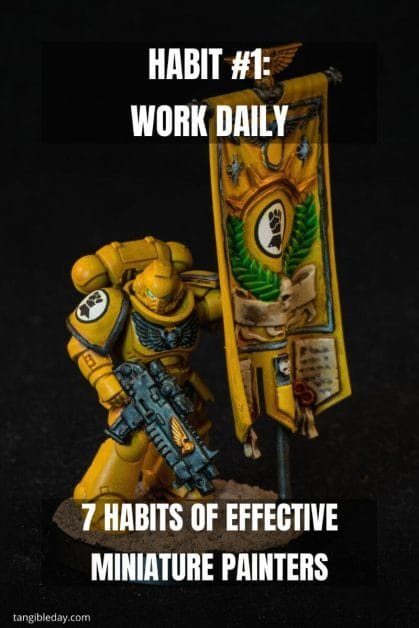
2. Volume, Not Perfection
Volume is the amount of art you produce. To get to a decent volume, you’ll need to avoid doing anything that slows you down. In addition to painting everyday, which will naturally increase your art volume, you’ll want to paint miniatures without worrying about the result being “perfect”. Perfectionism is an attribute of someone who is concerned with flawless execution, and worries about the negative evaluation of others. If you’re a perfectionist, you’re driven by fear (which, according to Frank Herbert is bad).
To get around perfectionism, you’ll have to stop thinking about flaws and start thinking about product. Here’s a reason to focus on producing a larger volume of painted miniatures, instead of a small number of “perfect” miniatures, if you want to improve your work. In any art making activity you do, you learn the most at the beginning parts of the activity.
The first phases of painting a miniature is where you learn the most. The last finishing touches, the glazing, the edge highlighting, and other fine details don’t help you much. Yet, these latter phases of painting a model take up the HUGE majority of time. So, there is a diminishing return to perfecting a model in terms of your learning to paint.
Rather, it is in the beginning when you’re painting blocks of color, e.g., base coating, and layering to create the composition where you really learn a lot. These early stages is where you understand how contrast drive the “structure” of your miniature painting. Learning to place the right paint values (i.e., brightness/darkness) to form proper contrast over the model is a major hurdle for many painters. Value, not color is what makes a miniature come alive. You learn most about painting value in those first few coats of paint.
To get around perfectionism, you’ll have to stop thinking about flaws and start thinking about product.
By painting a larger number of models, you gain more experience with the more important early phases of paint application. If you’re aiming for perfection, you lose out on the experience of practicing in the earlier aspects of the miniature painting process. When you get closer to the end of a miniature painting, you will slow down. Fine-tuning edge highlights, glazing to smooth out blends, or adding the correct specular highlights are important for display or competition pieces. But, you won’t learn as much investing time in these areas of miniature painting.
To improve your miniature painting, you need to focus on painting many pieces as possible so you get experience in early stages of painting under your belt. In other words, it may sound counter-intuitive, but I’m a firm believer that you learn to paint miniatures fastest by painting a ton of tabletop quality miniatures rather than a few high quality display pieces.
Speed paint armies if you want to grow as a miniature painter. That heavy upfront experience will be the foundation that drives your ability to produce competition level pieces when you ready and want to do go in that direction. Try it!
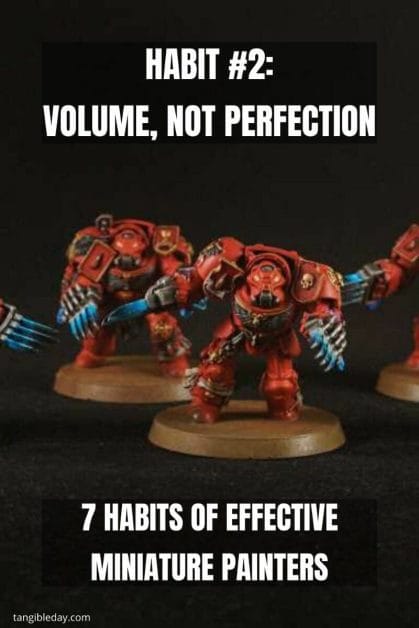
3. Copy Other Work
It is a myth that truly successful artists create works de novo from nothing. Ever piece of art is unique until you really understand where it came from. In reality, every impactful artist in history has borrowed heavily from prior work. For painting miniatures, you should get into the habit of copying other art to become a better artist. No, I don’t mean copy verbatim, stroke for stroke. Rather, copy the style and color of works you are attracted to. Use your power of observation and inspect the miniatures you admire.
I admit I research the exact model paint brands and brushes that my favorite painters use.
What are the aspects and elements about those painted miniatures that attract you? Can you reproduce those things on your painted model?
Maybe it’s a type of paint, color or texture. Or maybe, you love how the blends of color seem to flow naturally across the model. Whatever the case might be, copying parts of another’s painted miniature is a key habit you need to become accustomed to for improving your painted miniatures. I have examples of where I rely heavily on reference images (take a look here and here). That is, I use photos of other people’s work to help guide my miniature painting process. I admit I copy styles, and even research the exact model paint brands and brushes that my favorite painters use.
To improve your miniature paintings, learn to copy the aspects of other miniature artists. Marike Reimer has inspired much of my work, and I borrow heavily from her technique of using blocks of color and layering to achieve certain effects on my models (you can see some of them in the gallery).
I have also incorporated a lot from the works of Angel Giraldez, who focuses on using an airbrush for most of the miniature painting process. And, of course, I use love watching YouTube for inspiration about how to paint with all the other techniques for painting miniatures. I’ve even compiled what I learned about paint blending techniques into a single article.
Ultimately, copying helps you improve your miniature painting by helping you leapfrog over the phases of learning and mistake-making that other artists have already overcome. Why reinvent the wheel? Use reference images as much as you like! Do it. It will help you learn faster and become a more effective miniature painter in the long run.
When you’re “copying” other painted miniatures, of course, you’ll never perfectly match what you see. Instead, your personality and expression will seep into your painting process. In other words, copy other’s art to inform your natural style and learn from this process as you paint.
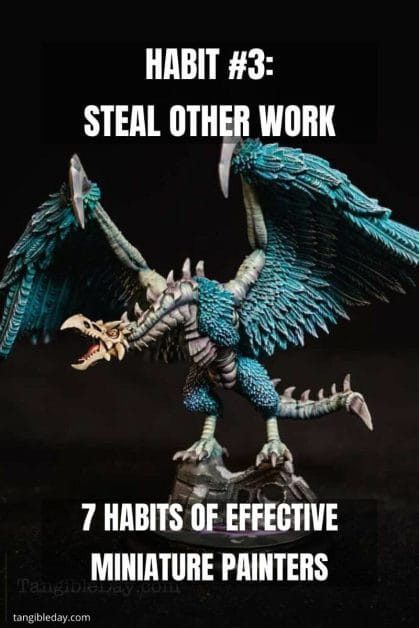
4. Conscious Practice and Learning
“Practice makes perfect”, goes the common saying. But, it’s oversimplified. You can’t just sit down and slop on paint the same way over and over on miniatures and hope that you’ll get better. When I was first learning how to paint miniatures, I figured that if I simply paint models using the same formula on everything that I would automatically get better. But, in reality, I was wasting time.
Here’s how you need to practice to improve your miniature painting. Work consciously about what you’re trying to achieve. Be mindful of your goals for the model. Are you trying to improve your first coats of paint, making them as smooth as possible? Do that by inspecting your model and see where your paint isn’t applied correctly and actively try and fix it on your next model. Practice thinning your paint ot the proper consistency.
When I first began painting eyes, I followed the same formula of putting dots of whites and blacks in the eye sockets of miniature faces. But, I wasn’t improving my ability to paint eyes. I needed to practice other aspects of “eye painting” (I like this tutorial). This meant actively trying to keep my irises centered within the eyeball, and practicing how to cleanly apply small dots of paint using a fine detail brush.
Don’t turn on the music or audiobook and doodle away your time on the same formulaic approach for painting your models. Instead actively push yourself to practice additional techniques and methods that help build upon your miniature painting foundation. These basic core skills need to be practiced, but within a mindset that actively tries to improve what you already know.
There is another saying I’ve heard that is more accurate: “Perfect practice makes perfect”. When a Samurai wields their sword, they repeat the same motions over and over. But, it is not a mindless action. Within a single movement, a martial artist who seeks perfection focuses their entire mental state, their spirit, into perfecting that movement.
An avid golfer will spend countless hours at the driving range to improve their swing. Each time they hit the golf ball, the golfer who is looking to get better is focused on tweaking how their body, arms, wrist and hands move along with the club. There is a mental and physical focus during this “practice” that undergirds the trajectory to mastery.
Don’t turn on the music or audiobook and doodle away your time on the same formulaic approach for painting your models.
As someone who is interested in photography, I often get into the bad habit of taking snapshots without thought of what images I’m capturing. When I’m doing photography this way, I’m not learning anything. I’m just pressing the shutter and the resulting images are junk. Crap.
It was only when I realized that I have to anticipate, envision the image before I press the shutter, that I began to improve my photographic images. When I’m using my camera, I consciously practice how to see the subject’s composition prior to capturing the image. This active practice, mindfully using my tools at hand, has helped me immensely to improve my photographic art.
Overall, it is this mindful approach you need to incorporate into practicing your miniature painting. And, this is kind of conscious practice is exactly the habit you need to get into if your goal is to become a better miniature painter.
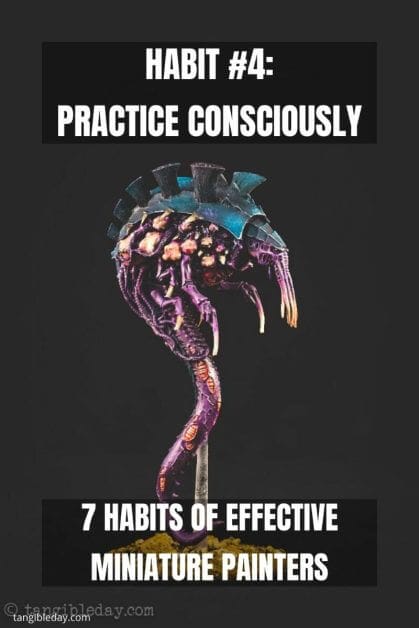
5. Rest
Every activity you perform needs to be punctuated by rest. This rhythm of work and rest a vital habit to internalize when you’re seeking better results with your efforts. When you rest, your mind and body “remembers” what it had experienced. Psychologists have described taking breaks or resting as a key part of developing “flow“. Flow is also known as “being in the zone” and is a mental state where you’re performing some type of activity where you’re fully immersed, enjoying the process, and energized (source).
Whether you’re aware of it or not, you may have already experienced flow. And, that pleasurable experience of being immersed in painting miniatures is something we’d all love to repeat every time we sit down with our brush and paints. More importantly, through the experience of flow, you are learning something new (though you may not consciously know it).
For best results, the creation process requires periods of activity and rest.
To enter flow and, by extension, improve your miniature work, you need to learn the habit of taking periodic breaks. The timing and frequency of how often you take breaks away from painting miniatures will differ person to person. Here’s a pro tip about making it easier to take breaks: Remember the first point of needing to work daily? It will be easier for you get into habitual breaks if you also break up the duration of your painting sessions across many days, instead of cramming all your painting sessions into a huge block of time in a single day.
There is something about how are brains and bodies are built that forces us to rest. We sleep at night because something in our bodies makes us sleepy. We know from science that to be healthy and grow we need to break up our 24 hour days into awake and asleep. The same is true for making art. For best results, the creation process requires periods of activity and rest.
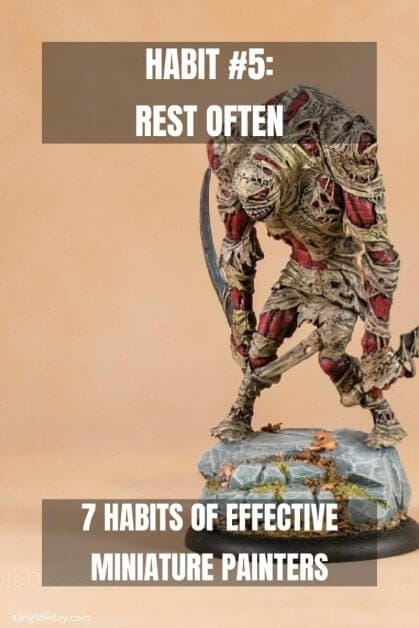
6. Get Feedback
This is probably one of the hardest habits to form for artists looking to improve their work. It requires that you actively seek input from others whose opinion you may not like. For most miniature painters who also play the tabletop games with our models, our interactions are generally limited to our local communities.
In this case, most of the critique we receive are from people who are also learning to paint or simply interested in other aspects of the hobby (e.g., playing the tabletop wargames). These may be useful and constructive, but often this kind of feedback reinforces our views of our pieces. To receive useful feedback you can use to improve your miniature painting, you need to find people who paint better than you.
The more information have, the better armed you will be when you approach your next project.
You need to ask people who you know are better at painting miniatures what they think, honestly, about your work. And, often that means receiving information that shows flaws (some major) that you never imagined you had. As much as this kind of direct, truthful (and often correct) feedback hurts your ego, it will be the precious information you need to incorporate into your work to get better.
If you’re a miniature painter who has a hard time finding people whose input you can trust in your local community, then you’ll have to go online. Social media is a great way to garner a diverse set of opinions about your miniature painting work. Of course, you’ll need to be comfortable sharing photographs of your painted miniatures in the digital public space. That also means you’ll have to learn how to take effective images with your camera of your painted models (here’s are some photography articles that may help you take better photos of your minis).
Useless feedback is the kind of information that doesn’t hurt you. Good feedback will often be painful, as it is shines a light on the problems in your work. I post often on social media, e.g., Facebook groups, Instagram, to share my miniature painting work and garner feedback wherever I can. Sometimes I ask for a critique, but most times I don’t. It’s scary.
Of course, if someone volunteers information, good or bad, I try not to take it too personally, especially if it’s bad. When it’s from a person I know is a good painter, I put extra value in their opinion of course, and will try and address that possible issue in the next piece I work on.
It bears repeating that if you really want to improve your miniature painting, get into the habit of asking for feedback on your work. It is so important to gather the perspectives from many people you trust to know how you are progressing in your art. The more information have, the better armed you will be when you approach your next project.
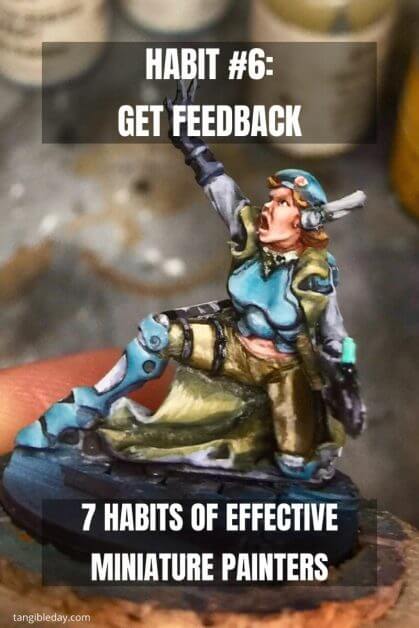
7. Create What You Love
Someone once told me earlier in my miniature painting hobby days to try painting models other than Warhammer 40k. Back then, I was still learning how to paint and realized that all I was painting were Space Marines. Games Workshop models were easy to find, simple to assemble, and fairly straight forward to paint up. You can use really simple techniques to rapidly paint up most of the core Citadel miniature kits. Start with a base coat, wash or dry brush, and highlight/accent your model: done! I love painting these models and learned a lot during this time.
But, when coaxed by a friend to improve my miniature painting quality he suggested trying to paint models that had a less sci-fi theme. They were fantasy models consisting of monsters and characters with more organic, humanoid forms. I gave those models a shot, but I was not fully immersed in the look and feel of those miniatures. I just couldn’t get into the groove. Alright, let’s be honest. I hated painted those models. Yet, for the sake of trying to get better at painting miniatures, I pushed myself to complete the project of painting some of those miniatures.
You’ll learn faster if you focus on working with miniatures you love painting.
In retrospect, I don’t think I painted those models very well. And, I blame this failure to produce good results on the fact that I just didn’t like them. I didn’t enjoy the process of painting miniatures I thought were ugly to begin with. Consequently, this led to me naturally speeding through the project as quickly as possible using rote techniques that didn’t teach me anything.
If you’re looking to improve your miniature painting, incorporate the habit of avoiding art making that you don’t want to do. No one is forcing you to paint miniatures you don’t like. In this world, there are many rules we have to follow. What to properly wear to work, how to behave in public places, and when we have to pay taxes. Art is liberating because we have the option to do whatever we like.
Suffice it to say, when I went back to painting those Space Marines, I continued to improve my work because I was enthralled with the plastic models. I loved their look, their dynamic poses, and the backstory of the models within the Warhammer 40k Universe. I sought out YouTube videos and other online instructions for ways to improve how I painted these miniatures. Eventually, of course, I branched out and painted all sorts of models that I loved the look of.
Another line of miniatures that I thoroughly enjoyed painted and learned a lot during the paint process were the Grymkin line of miniatures from Privateer Press. You can see one of the Grymkin “Skin & Moan” models I painted here. I learned a lot about how to use oil washes in combination with acrylic dry brushing to create the effects on that model and many others in the Grymkin model line.
When you’re looking to get better at painting miniatures, focus on working with models you love painting. Successful professional artists in other genres, e.g., music, traditional or digital painters, dancers, have gotten to their position because they focused on doing things they love.
Not only will you devote more effort and attention to models you love, you’ll enjoy the painting process as well. You’ll learn faster if you focus on working with miniatures you love painting. Why make a habit of making your life more miserable, when instead you can choose to habitually do things you enjoy?
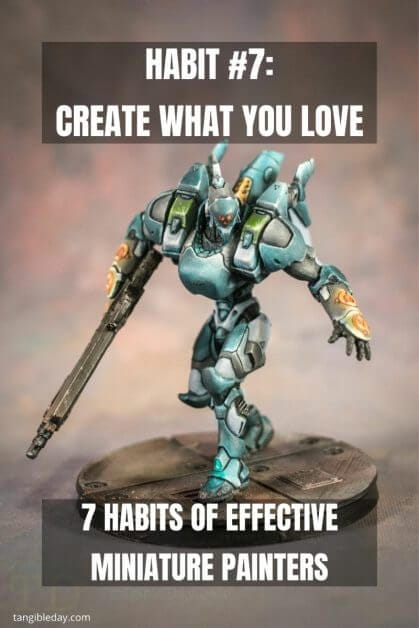
Final Word
The habits of great miniature painters are universal across different art forms. To become a more effective artist, work daily, produce a lot of work, copy other artists, practice consciously, take breaks, get critiques, and do what you love. As mentioned, you may have already discovered that you already incorporate some or all of these habits with your miniature painting hobby. If so, keep going and let me know if there are any other things you do that have helped you improve your miniature paintings.
I’ve painted a lot of miniatures over the years. I’m still learning new things everytime I sit down with my miniatures and continually look for ways to improve upon things I already know how to do. I love the process of discovering new ways to approach old problems with my work. This often means experimenting with new mediums, like oil paints, or using different mediums to change how paints appear on a model. I hope you stick around and check out the other articles on the site and see what I’ve learned along the way.
Thank you for reading! Happy painting!



Tangible Day on YouTube (Miniatures and More!)

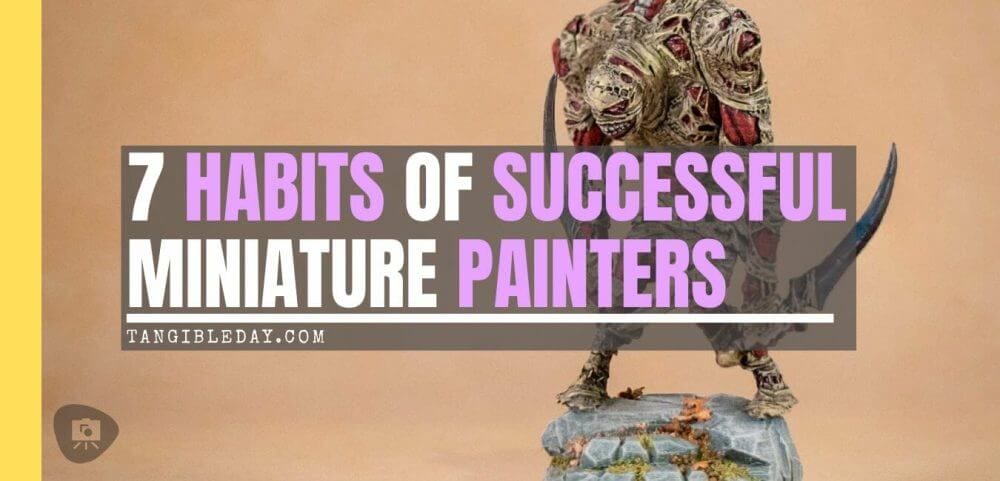
Pingback: 7 Habits of Effective Miniature Painters — Tangible Day | Ups Downs Family History